Prep Football: Mark Morris pumped out quality QB's in the 1970's
The GOATs — Sam Tilton led MM to 1979 title tilt; still remembers Monarchs who could sling it
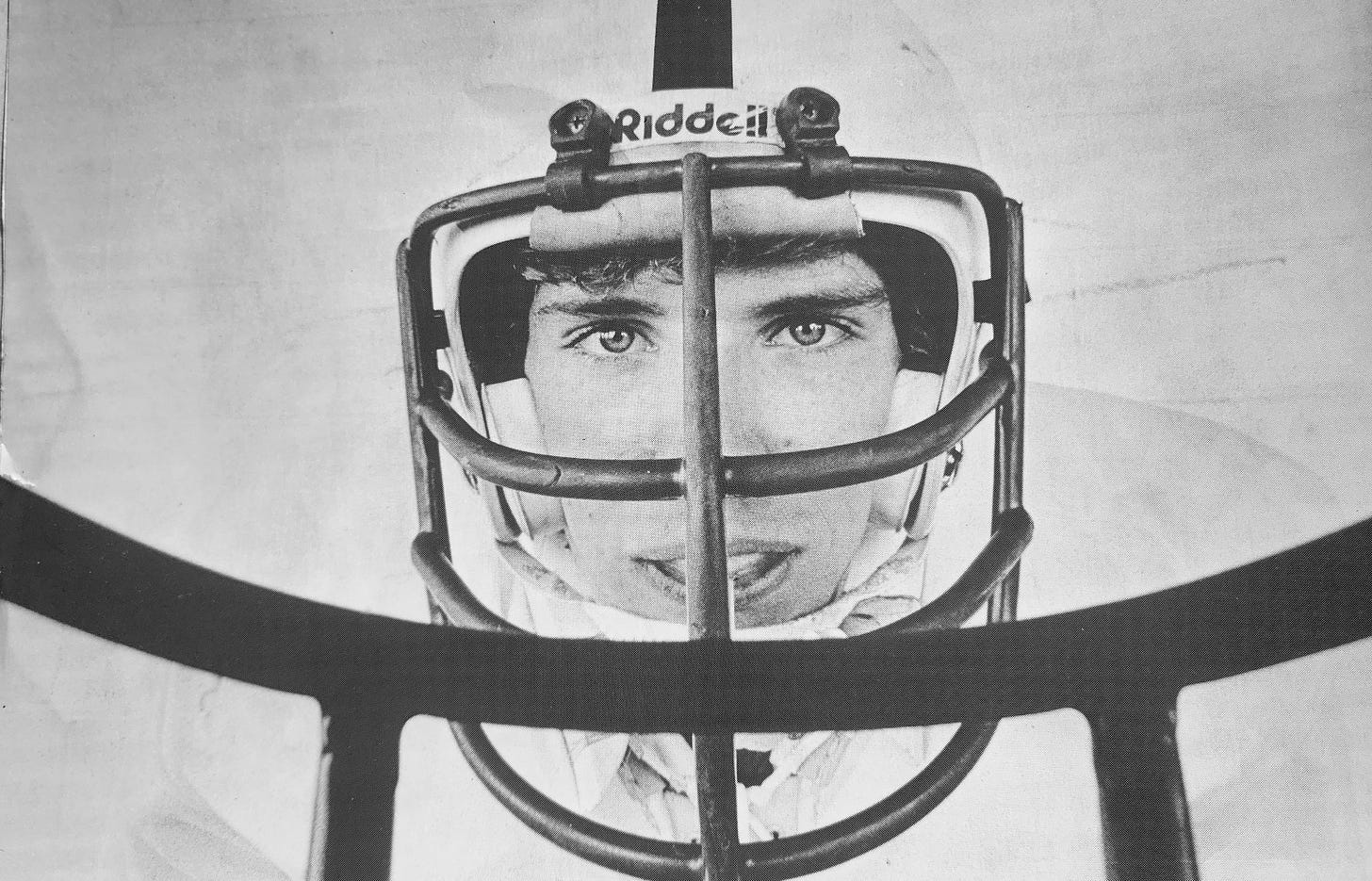
Editor’s Note: This is the second installment in an unlimited BZM series where we are trying to determine the greatest local high school quarterbacks of all time for every school in the Blast Zone. You can read the first story, here. And be sure to write in to tell us your opinion on the subject, because that’s what matters most.
Sam Barbee and Jordan Nailon / blastzonenews@gmail.com
Longview Memorial Stadium is a thing known to most around these parts. When I was in high school, the Longview schools got bumped down to the 2A ranks thanks to a consistent downward trend in enrollments which could be fixed, or at least curbed, with a switch to just one high school in town. But that’s a different topic for a different day. For now, we’ll stick to talking about that season where we first saw Woodland and Ridgefield added to the league schedule.
That season of change was 2007 and I distinctly remember the steel-footed Tim Kalal, at that time an assistant coach with R.A. Long football, telling us that he’d heard the Spudders talking about how this place felt like a college — what with the school over there and this huge stadium looming above us.
The dueling wooden stands, first erected in the late 1920s out of locally sourced old-growth timber, behind the looming bell tower of the planned city’s original high school are gone now. One was replaced in the 1970s with a concrete structure, the other was torn down a decade ago and never replaced, its rotten support beams the reason for its demise.
Its grass, too, has been replaced by artificial turf and painted in the colors of the two schools that have shared it for nearly seven decades. All those footsteps of players, parents, marching bands and graduating seniors are now entombed beneath a veneer of synthetic polymers.
On the far sideline, jutting out against the vaunted Lumberyard baseball field with its odd curved fence down the right field line that has caused more than one super weird play, is a new all digital screen scoreboard that replaced the first replacement a couple of years ago. That one, the original replacement, was also over on the west end, with a baseball scoreboard tacked to the back of it. If you don’t remember that, it was truly weird.
Fifty years ago, when passing the football was still considered a weak man’s ploy, the scoreboard at Longview Memorial was on the opposite side, tucked into the southeast corner above the pop-up concession stand.
And behind that, now grassed over with a pole-vaulting track, was where the youth of Longview dependably converged to prepare the town’s upcoming crop of athletes in the arts of tackles and two-hand touches, all while the current prep stars churned up that once hallowed grass.
By the way, kids still do this. But not at Longview Memorial, where it’s been outlawed in the name of liability and order. But just the other night, while performing my duties as a gridiron official, I had to wag my finger at a group of excited youths in Warrenton who let their ball get loose into the end zone during a point after kick. Even with that transgression on record, the tradeoff in memories and experience is worth it.
And it was there, tucked into a rowdy corner of the grounds at Longview Memorial, where Larry Peck watched Tom Chamberlain quarterback the Mark Morris Monarchs with the awe of a child’s eyes.
Peck Remembers Plenty
He might not be super happy with me putting it exactly this way, but that was a long time ago. It was before he played at Mark Morris. Before he went off to college to play some more. Before he coached the freshman at R.A. Long right out of college, what he called his favorite coaching job. Before he coached at Battle Ground for most of forever, and before coming back to RAL during the same time period when I was wearing shoulder pads on Friday nights. It was certainly before he joined his son Mike’s staff at Prairie, and generations before he made it back home to coach with his son again at Mark Morris.
Standing on the sideline of a place that is barely, yet always, familiar while a pre-playoff practice created a din behind him, the elder Peck thought back to those days of simplicity and awe.
Tell me a story about an old quarterback, I prompted. Then I stood back and listened.
The first name that came to his lips was Tom Chamberlain. I wrote some – but not nearly enough – about Tom in the first dispatch of this series.
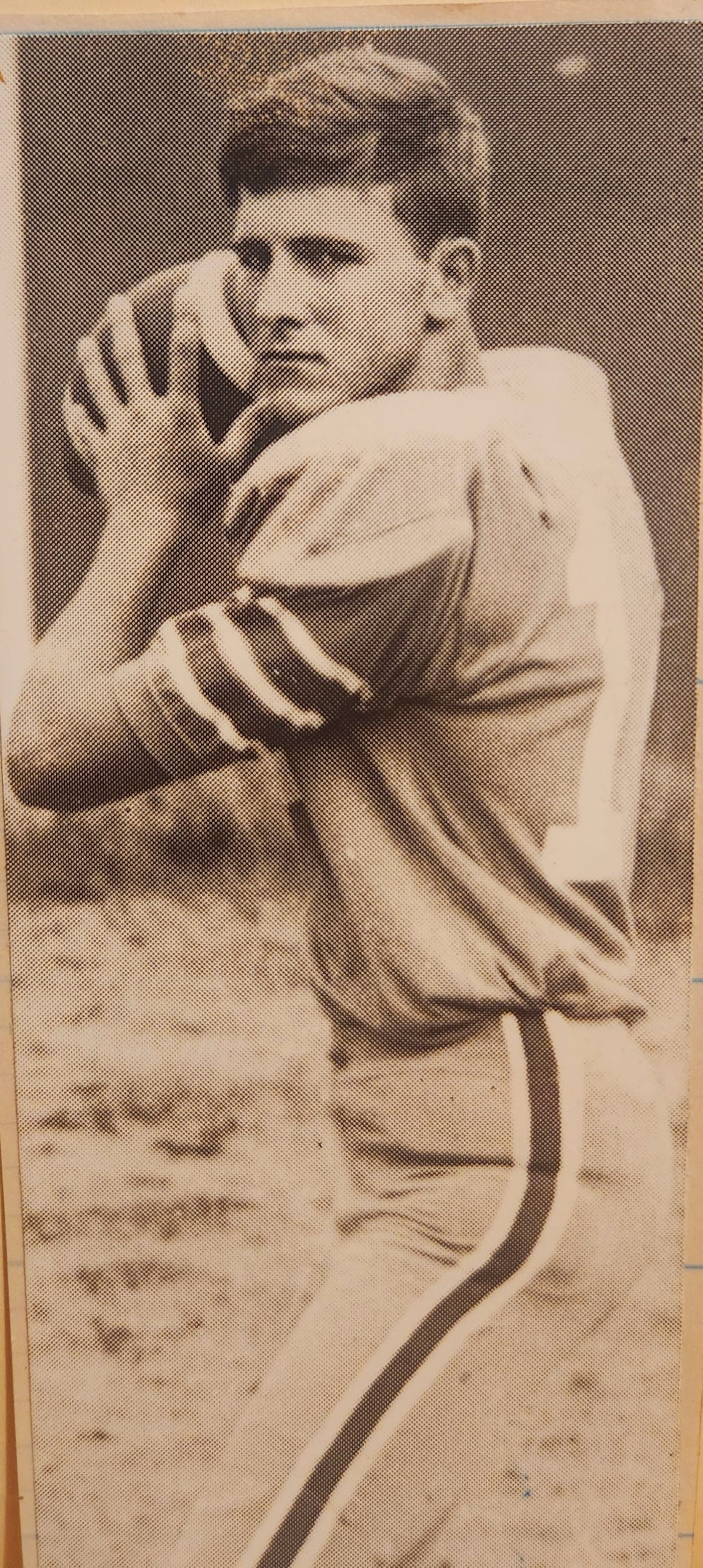
The man was big, even then as a high schooler. His older brothers, Marv and Vern, played fullback and were good in their own right. Marv is in the Washington State University Hall of Fame as a pitcher and Vern got a full ride to play for the Cougars, as well.
And Peck wasn’t the only one to notice.
“You’d be hard pressed to find a family with three Pac-10 kids,” former Monarch Darren Talley said.
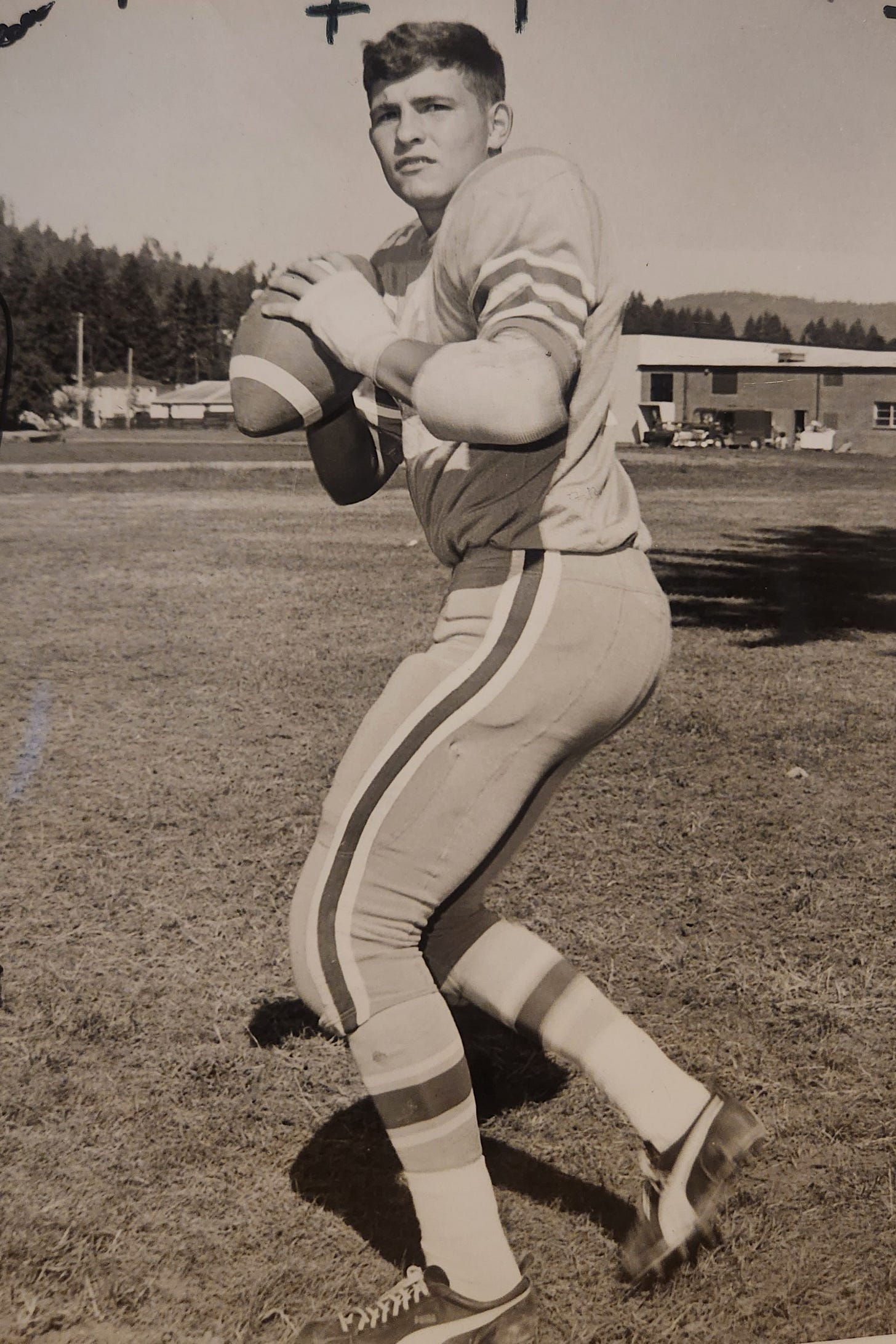
Tom Chamberlain went to Oregon State where he played defensive end/linebacker and pitched. It was baseball that saw him have the most success, as he pitched through the St. Louis Cardinals organization until AAA, but never broke through to the major leagues. In his age 26 season in 1981, Chamberlain had a 5-7 record over 26 games (20 starts) and a 4.43 ERA over 126 innings.
He would never pitch in affiliated ball again.
But we aren’t talking about local baseball players. We’re talking about quarterbacks.
So let’s talk about Tom Chamberlain as a quarterback.
Remember when I quipped that passing was eschewed in the 1970s? I wasn’t joking. It was. But you probably don’t need me to tell you that. Many coaches in these parts still consider throwing the ball to be some sort of newfangled gimmick.
But, as Peck noted, Chamberlain is one of those guys who you could teleport from the past into the present and he could, without a doubt, excel playing in today’s game.
In fact, he might’ve even liked it better.
Big and tall with a spaceship engine attached to his shoulder with accuracy, to boot, Peck called Chamberlain a pro-style passer. He also came with the attributes of being strong and tough. His release was clean and quick and smooth. The ball jumped out of his hand.
And based on the way Peck talked, I don’t think Talley’s previous claim of Chamberlain being capable of throwing it 70 yards is any sort of tall tale. Heck, I wasn’t that good and I could throw it close to 60. But our balls were lighter and easier to throw.
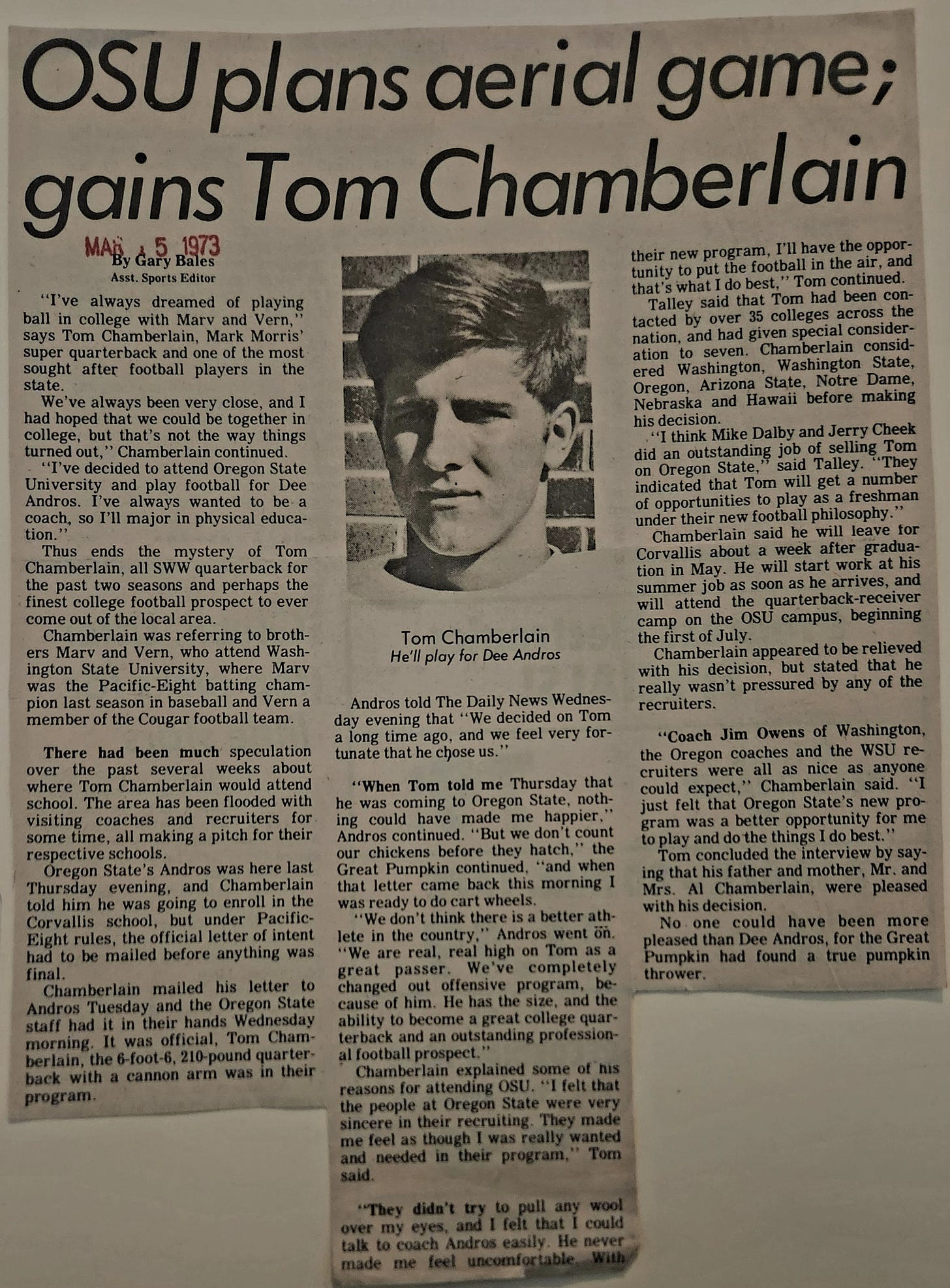
“Oh, he would’ve been one of the best in the state, throwing the ball in the modern system,” Peck said without hesitation. “But he was also accurate. You give him four good receivers, and a decent pocket – he would’ve been a pocket guy, NFL-type stature – and he just had a rocket for an arm.”
You see somebody like that sling it enough times, and at the right age, and it sticks with a person forever.
“As a little kid growing up in this town, you would just marvel,” Peck added. “You’d come to the game and watch it right here on the field. You’re right, they didn’t throw that much. But if they did, if it was unsuccessful, it wasn’t because he missed the receiver.”
The Next Episode

Peck graduated from Mark Morris in 1977, playing his final season on the prep gridiron with a senior-laden group full of expectations that fell in the first round of the playoffs. His turn under the Friday night lights had come to an end, which meant it was time for new players to make legends of themselves in the eyes of the children in the grandstands and those ringing the track.
Which brings us to 1979, a year that meant nothing to institutional knowledge-lacking folks like me until very recently. But to the Monarchs, especially those who remember, it means everything.
That’s because it was the year Del Talley took an overlooked Monarchs squad, quarterbacked by a smooth lefty junior, all the way to the state championship game at the concrete cathedral known as the Kingdome in Seattle.
That southpaw signal caller’s name was Sam Tilton. And he has stories.
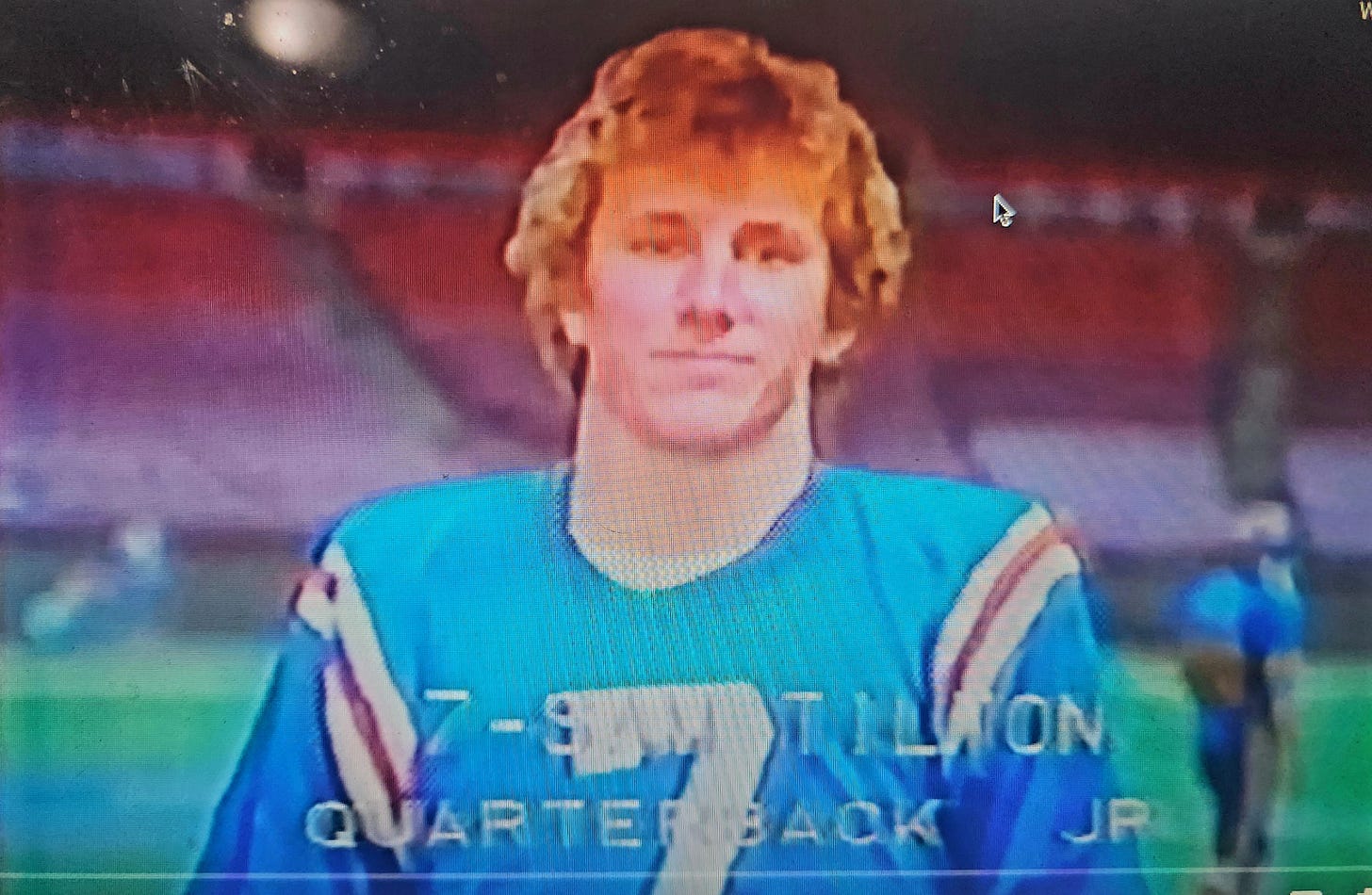
Tilton may not have been the most athletic Monarchs quarterback ever. He did run a 4.6 40-yard dash in college (not bad, and we’ll say more about that later), but he was no Tom Chamberlain. And even he’s okay with that scouting report. But if winning counts in the discussion of who is the greatest ever, then Tilton picked up bonus points by delivering in the clutch.
That 1979 State title game can be viewed on YouTube, thanks to Teddy Campbell, a wide standout wide receiver on that team. We’re gonna go through the footage in a second. But first we need to set some things up.
Even as we approach 50 years of dust on the game tape, it’s easy to see why Tilton was a good quarterback. The position is so much more than just throwing the ball. For instance, I had the physical tools to play the spot, but not the composure, not the inherent leadership, not the poise or the patience or the calmness or the confidence. New coaches kept seeing me throw before practice and getting wild ideas, before watching in horror as I became absolutely atrocious once the bullets started flying.
I got the impression this week, sitting in a small school cafeteria and talking into my phone, that Tilton was all those things I wasn’t. He was calm. He was confident in himself and his teammates. He engendered trust and belief. Oh, and he could rip it too.
Even if I’m making these up, even if you’re doubting I can make these leaps based on a relatively short phone call, these are things that have to be true about the 1979 Monarchs. Because the story on its face doesn't allow for another interpretation.
Of the Monarchs’ 22 starting spots on offense and defense, only two had returning starters. It had been an exodus in the offseason, and the general feeling was coach Del Talley and the Monarchs missed their chance at that elusive AA title, and Arlington or West Valley (Spokane) or Hoqiuam was gonna do it that year.
But not the Monarchs. Their coach would not allow it.
The way Tilton describes Talley as a coach is, I imagine, the way someone described Rome the first time seeing it in the season of 37 BCE. So much awe. Even now, Del Talley is barely human in Tilton’s mind. He has transcended mere sports and become a living legend.
“Del was inspiration,” Tilton said. “He had a way to get inside of you to pull out the courage and to get rid of the fear and make it bigger than it was. Almost a mystical experience. His pregame speeches were spellbinding. His mannerisms were – he was kind of like George Patton, I guess. In a good way.”
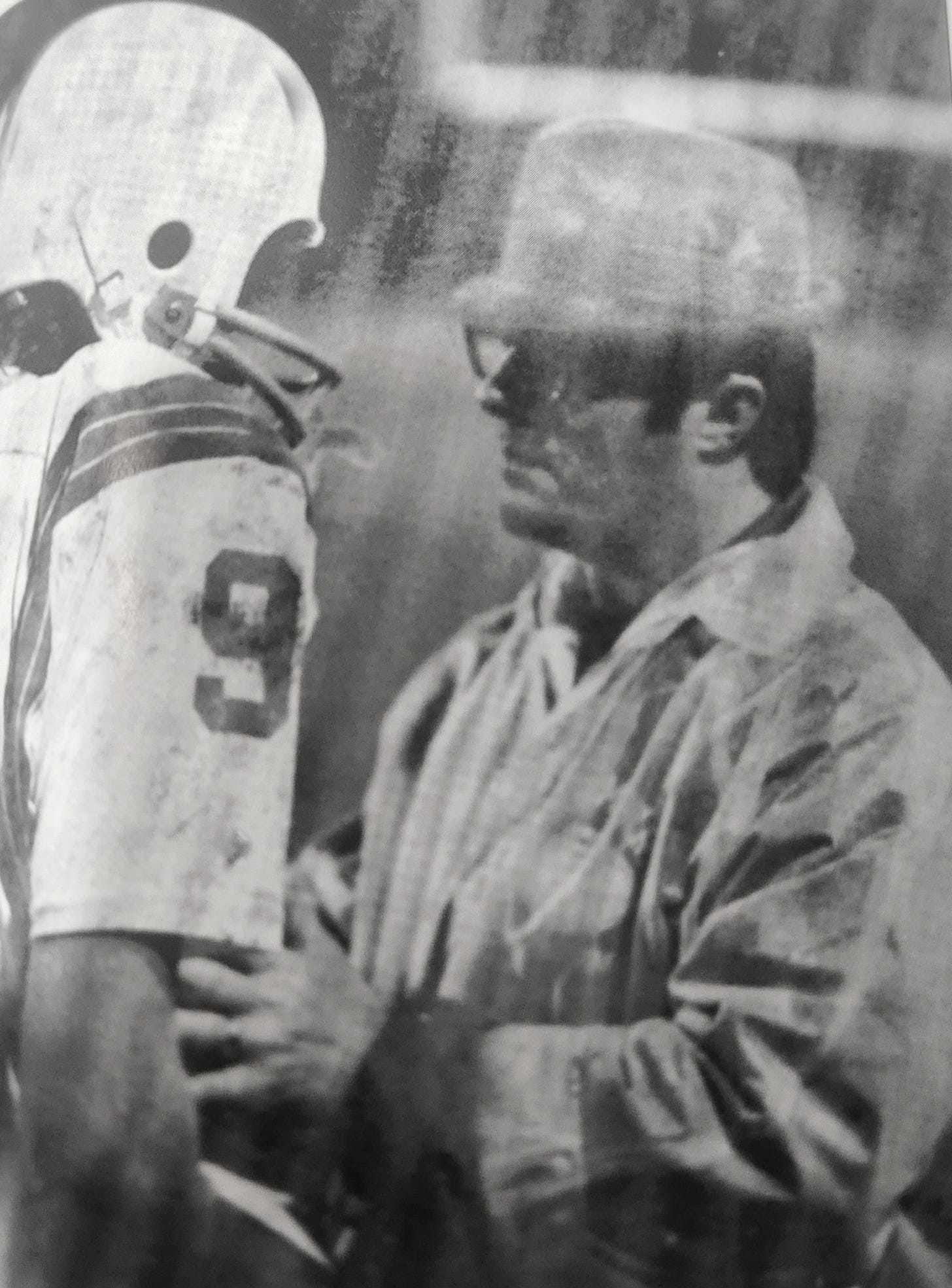
Talley was largely coaching the Monarchs alone.
Assistant coach Jim Kickabush had to step away from the program midseason due to his battle with cancer, and one of the last things he saw was MM playing for a title. The wide receivers coach quit, but Titlon didn’t remember why. Another coach took a job somewhere else. Fred Amrine, father to current Kelso coach Steve Amrine, came to help out at some point, but for most of the season Talley coached the team without a proper staff.
And still, they were good.
Allan Peterson played fullback and was as physical and relentless as you remember, or can imagine. Campbell was Tilton’s favorite target. They had a connection that wasn’t unlike the mythical synergy of Johnny Unitas and Raymond Berry. Tilton always knew where Campbell would be, and this continued into their college careers at Azuza Pacific. Oh, and Kevin Bogner was an always reliable tight end.
Despite losses to Kelso, Camas and Tumwater (sounds about right, even now), Mark Morris found itself playing Pullman in the semifinals of the 1979 tournament. It was a cold day in Yakima. Actually, cold doesn’t cut it. The field froze. The fog rolled in. The wind whipped. It was miserable.
Someone brought a charcoal grill down from the stands and lit it up on the sideline. Tilton spent much of his time with his hands to the fire, trying to keep some sensation in his digits. Mark Morris wasn’t gonna throw a ton. But just in case. Just in case, he’d be ready.
“We don’t throw a lot but when we do throw it’s been pretty good to us,” coach Del Talley told the media before the 1979 game. And coming off that semifinal contest, it’s easy to see why he phrased it that way.
Tilton threw four passes that day. Three went for touchdowns. Mark Morris would play for a State title.
“It was surreal,” Titlon said after turning down The Eagles blaring from his home speaker system earlier this week.
And if the semifinals were surreal, the Kingdome was a different kind of thing entirely. The lights were directly overhead, so the ball would never get above them and disappear, like they were used to at high school fields with incandescent light bulbs pointed down. The field surface was a thin layer of bright green carpet thrown down over a concrete floor, the Seattle Seahawks logos covering midfield and the end zones. Artificial “grass” wasn’t nearly as common back then so Mark Morris borrowed turf shoes from UW, and Tilton recalls that everyone hated the way they felt. There were seams in the turf, and some guys got their ankles caught in them and got hurt.
“I don’t know how the pro guys dealt with it,” Tilton said.
The answer is they dealt with it the same way. The pros got hurt, too.
But the film on YouTube is fantastic. You really should go watch it (here’s that link, again). There’s so much stuff that jumps out at you instantly.
Some MM players wore gold helmets! Maybe like five? It’s kind of hard to tell. They were called the headhunters, and earned their golden lids by turning in violent hits that made the coaching staff take notice. Doesn’t seem like something you could do now.
Before the game, the TV crew did player intros. Each guy had a chance to stand in front of a camera and stare into the electric abyss. Later they were announced and got to run down the sideline, alone, with all eyes on them.
Here are the names of the Mark Morris starters on the final day of the 1979 season.
Number 53, Mark Fisher, Jr. Number 63, Dan Kohler, Sr. Number 76, Phil Walker, Sr. Number 72, Tim Moore, Sr. Number 73, Phil Burgin, Sr. Number 81, Kevin Bogner, Jr. Number 80, Ted Campbell, Sr. Number 22 Rob Poole, Sr. Number 44, Allan Peterson, Sr. (with a gold helmet). Number 24, Tony Uzeta, Jr. And Number 7, Sam Tilton. He was the only one who said, “Hi, Mom” with a little smile. Everyone else looked deathly serious.
Then there was Number 84, Jim Svinth, Sr. Number 77, Dave Harlin, Jr. Number 78, Jay Steward (looking confused), Jr. Number 12 Bob Williams, Sr. (gold helmet). Number 39, Rob Leggett, Sr. Number 32, Steve Strader, Sr. Number 87, Eric Van Zanten, Sr.
See some names you recognize? I sure do. And a whole lot of permed haircuts.
Arlington won that game rather easily. But it doesn’t matter. It wasn’t the game that Tilton remembered. It was the little things. Walking into the Kingdome and the locker room for the first time. The togetherness of the team.
Sam Tilton isn’t on this list because of what he did, necessarily, even though he threw for more than 100 yards with a 23-yard touchdown strike to Campbell in the mix during that title game. In the first half Tilton even connected with Campbell on a 40-yard jump ball to jumpstart the Monarchs opening scoring drive
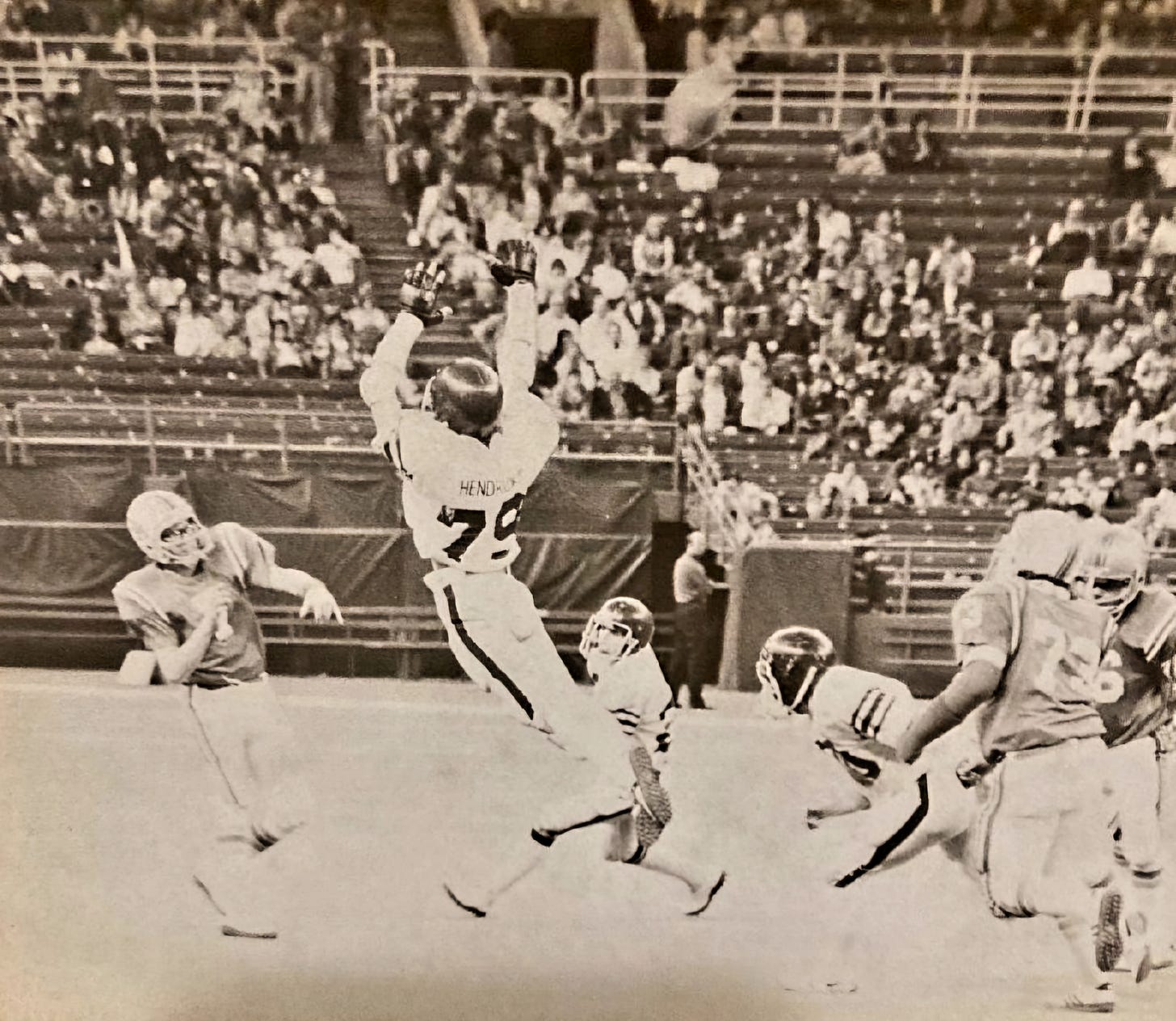
That play is well-known to Hayden Tilton, Sam’s son and a former MM quarterback himself a little more than a decade ago.
“My dad has an old VHS of the Kingdome,” said Hayden Tilton, now an assistant coach on the MM boys basketball team. “He’d show us a bomb he threw to Teddy Campbell. One of the only highlights of that game.”
But again, Sam Tilton is on this list because of what the team did, and as a result he’s the only Mark Morris quarterback to ever play in a State championship game. He’s also one of only three Longview signal callers to every play in a title tilt, and the most recent since Mike Polis took the undefeated Lumberjacks the distance in 1967.
That’s why I listed all the starters names. That’s why I spent so much time there. Tilton didn’t talk about himself. He talked about the team.
“It was a complete team effort,” Tilton said. “I remember the tremendous confidence our coach put in us. He always had that kernel of, ‘We can do this.’ Not that we were indestructible, but we were a strong team.”
That loss in the state title game would be Del Talley’s final game as head coach of the Monarchs.
Taking Stock of Talent
After that season, Tilton went south to play ball at Asuza Pacific University.
Already on campus was a track thrower from Nigeria who wasn’t super interested in football but was on good terms with the coach. A football coach? Working a track and field athlete to join his team? Never!
This particular thrower was really good at discus and the hammer throw. So good, in fact, that he won an African Championship in the discus.
But political and ethnic tensions in his home country kept him from competing at the next level of competition. Was it the Worlds? Would it have been the Olympics? Tilton wasn’t sure – but the result was that the excellent thrower walked away from track. And sprinted onto the gridiron.
You might know this name already. You might not. You might not have any idea what I’m talking about. But you’re about to learn.
His name was Christian Okoye. A little-remembered (except by those who watched him) running back who was drafted in 35th overall in 1987 and played for the Kansas City Chiefs through 1992. He also had one of the best nicknames in American sports history; The Nigerian Nightmare.
My man Okoye was gargantuan. He made NFL players look like little kids. Like pee wee players trying to tackle an adult. An adult who was wearing the biggest shoulder pads you’ve ever seen.
Okoye showed up at Azusa Pacific having natural talent but had never lifted a weight. He left Azusa Pacific squatting well over 700 pounds and benching more than 400. Tilton remembers one time in a gym a basketball randomly bouncing over to Okoye.
He grabbed it, held like “like a watermelon” and looked up at the 10-foot rim above. Something seemed to click in his head, Tilton remembered, and he jumped – flat-footed! – and two-hand yammed it home.
Another time, the football team was getting ready to run its timed 40-yard dashes. Okoye, who lived just below Tilton, asked if the quarterback wanted to go run. Tilton agreed. So they did.
Tilton ran a 4.6 that day. Not bad, actually. Especially then. And especially for a quarterback.
But Okoye?
“He was blowing the doors off my shorts,” Tilton said. “I thought there was something wrong with me.”
There were three coaches there that day, running stopwatches. They clocked Okoye at 4.37. He weighed 255 pounds.
“Of course, they had to round it up to 4.4,” Tilton said.
The GOAT Herd
I asked Tilton who he thought should be included among the best quarterbacks in Mark Morris history and then sat back and listened.
He mentioned Chamberlain, and became the third person to confirm that he could throw it 70 yards on the fly. Tilton also noted that Chamberlain once threw for 500 yards in a junior high game on the hill at Cascade Junior High in the late 60s or early 70s while throwing to a kid (name’s sometimes get forgotten) who later ran a 10.5 second 100-meter dash. He said there’s video somewhere. Does anyone still have it? Does anyone remember?
Editor’s Note: Sources say the name of that speedy receiver is John Mason, who went on to play wide receiver at Olympic Community College in Bremerton.
“(Chamberlain) could split your fingers if he threw it hard enough at you,” Tilton said.
Like Darren Talley before him, Tilton also mentioned Greg Cowell. He battled injuries but still earned a full-ride from Washington State, even if he didn’t have the college career he’d hoped
And there’s Reese Baker, who to many kids growing up in the 1990s and early 2000s elicited feelings of awe as if he were God. No, he was more than God. Because sometimes people say bad things about God. But nobody said anything bad about Reese Baker.
Like Chamberlain, Baker was putting up stats that would make a fantasy owner blush while he was a Cavalier in middle school. Similarly, he would go on to find more success on the diamond after wrapping his prep football career running the triple-option with the Monarchs. He first took his lefty arm to Lower Columbia College, before rounding out his run as a pitcher at WSU.
And still, we’d love to not ignore Cowell. His name continues to pop up and his ability to spin a football sounds really impressive. We just haven’t found the right person to tell us exactly how he did what he did, and what it was like to watch.
“He had rip and a zip on the ball that was on another level,” Tilton recalled. “(He) had the poise and the acumen. He had the X-factor.”
He also spoke of, Casey Tilton, but mostly to remember the time his younger brother accepted an invite to play pro football in Europe, only to lose his passport in transport and wind up detained at customs.
And yet, for all of this talk about Mark Morris (and those shiny gold helmets!) it’s worth noting again that even in MM’s greatest season to date the Monarchs still lost to Kelso 19-13. And since winning has to count for something (see: a lot) this is where we’ll note that Kevin Clark is believed to have been the quarterback of that 1979 Hilanders squad.
While we’re talking about the Hilanders let me say something controversial — Ed Laulainen Jr. is not the best quarterback to come out of Kelso.
Prove me wrong. Or right. That’s not the important part. But somebody has to think something. After all, Kelso’s got its own Quarterback Club.
Hollder At Us
This is the second installation in an unlimited special feature series, but we need your feedback to keep the ball rolling. Be sure to write in to tell us what we got right, what we got wrong, and who you think is the greatest local quarterback of all time. Please reply in the comments below, or send emails to: blastzonenews@gmail.com
About The Author: Sam Barbee is a former R.A. Long quarterback and a southpaw by nature. He is a regular contributor to Blast Zone Media and a former sports reporter for publications including, but not limited to The Daily News. To read the first installment in this series, click here.



One of the best, fellas. LOVE what you're doing with our areas history. Keep it up!